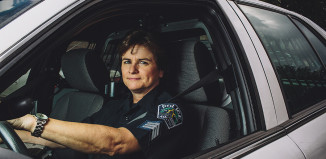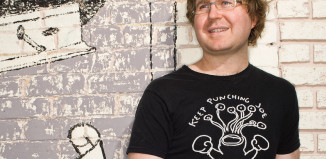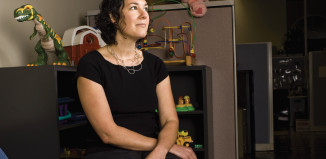Which audiences do you think get the short end of the stick?
Obviously, the studios often overlook movies that focus on gay characters and those that focus on nontraditional portrayals of women. But even in our films that target the LGBTQA audience, we are providing an alternative within that genre. Our films have a light touch and are not so much about sex and romance as they are about identity.
What was your first project at Daisy 3?
29th and Gay was our first feature film. It’s about a guy looking for his place in the world and for another guy to share it with. James Vasquez wrote and starred in it, and I directed it. James, his real-life partner Mark Holmes, and I produced it. And we were basically the entire crew, too. It was very bare bones. We didn’t really know what we were doing, but sometimes ignorance makes you fearless. So we just dove in and taught ourselves how to do it all.
What did you learn about the business of filmmaking?
By necessity, we had to learn about all aspects of filmmaking because we didn’t have the resources to hire anyone else. That kind of hands-on experience really forces you to stretch yourself into areas you wouldn’t otherwise. We learned about all the paperwork that goes into filmmaking, the exact amount of equipment one needs to shoot something, how to inspire people into working for little or no money, how to edit a film from the opening frame to the last credit, how to sneak into and out of locations without permits, how to get permits as a result, how much time, energy and money it takes to apply to film festivals, how to feed people with pocket change, etc. I learn something new every day. And each project gets more and more complicated as we evolve, so there’s ever more to learn.

The Daisy 3 team: James Vasquez, Mark Holmes, Carrie Preston. Photo courtesy of Daisy 3 Pictures.
How does a typical film go from idea to screen at Daisy 3?
We spend a lot of time on the scripts, refining them and getting them to a really solid place before we even think about shooting them. We also try to tailor the scripts to our budget levels. Then it’s a matter of scraping together our resources and getting ourselves profoundly prepared for the thrill ride that is filmmaking.
What do each of you (you, Mark and James) bring to the table in terms of skill and perspective?
James and I studied acting at Juilliard together, so we have that common artistic language. And our directors’ eyes are extremely compatible. But we would be 100 percent lost without Mark Holmes, who is the tech genius of the three of us. He is self-taught but knows more about that end of things than most people I’ve run into in the industry. He knows how to work and maintain all of the computers, software and camera equipment—necessary to run a production company, and believe me, that’s no small feat.
How do you personally want to change the way LGBT characters are typically portrayed in film?
I would honestly like to get to a place where a character’s sexual orientation is only one of the many, many things that defines them. As with any movie, I want to see well- drawn, beautifully studied and singular characters dealing with the complexities of humanity… oh, and those individuals also might happen to be gay.
That’s What She Said is full of cringe-inducing humor. Are you a lover of awkward humor?
I’m a lover of comedy that stems from truth. I feel like audiences have been literally and metaphorically watching men grab their crotches on screen since the beginning of film, and I feel like it’s time to let women do that, too.
Which female-driven films have influenced your directing style?
I am a big fan of Nicole Holofcener’s films: Walking and Talking; Lovely and Amazing; Friends with Money; Please Give. Although the style of That’s What She Said is more heightened than these films, I’m definitely inspired by how Holofcener puts flawed and culpable women on screen and lets them fall apart at the seams.
What did you set out to accomplish with this film?
Women often gauge their self-worth by the quality of their romantic relationships. But often more deeply relevant are the bonds with their female friends. Friendship and sisterhood become the true measures of self-esteem, and women bond with each other by talking about their romantic relationships. With That’s What She Said, I wanted the audience to get lost in these women, with these women, up close and personal, flaws and all, and then see themselves in them too.
How did you want it to stand out from other romantic comedies?
I wanted to make a “wo-mance” in answer to the “bro-mance.” [These women] are not the standard Hollywood issue: preternaturally gorgeous, wedding- obsessed, boy-crazy, fashion-focused, sexed-up child- women. They are real women, comically portrayed, who are wrestling with the very expectations of womanhood that Hollywood movies propagate. So perhaps we are the older, wiser, crustier, edgier, more real sister to the Hollywood romantic comedy.




































